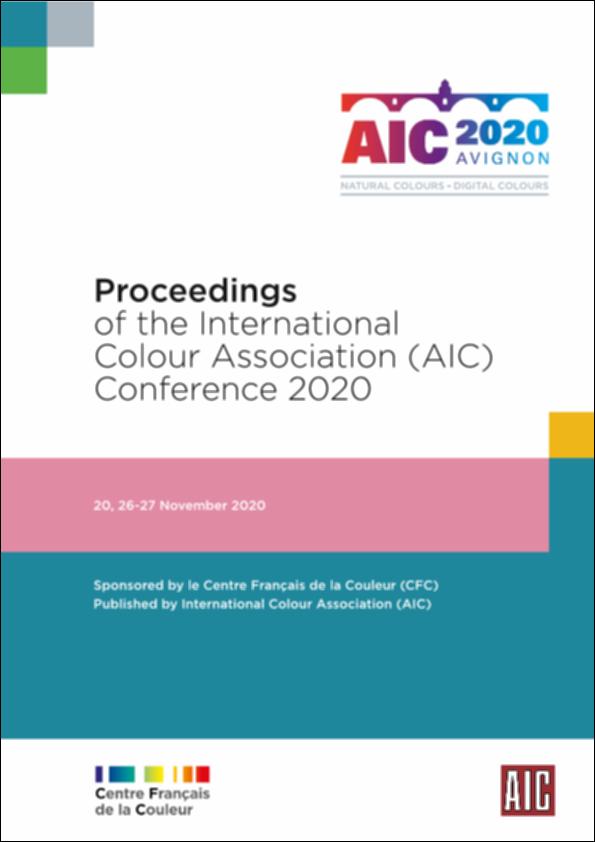Por favor, use este identificador para citar o enlazar este ítem:
http://hdl.handle.net/10637/14758Yērāqôn, a natural colour: ‘the colour of the fear’ (Jer 30.6)
| Título : | Yērāqôn, a natural colour: ‘the colour of the fear’ (Jer 30.6) |
| Autor : | García Ureña, Lourdes |
| Materias: | Colour; Emotion; Paleness; Bible |
| Editorial : | Centre Français de la Couleur (AIC) |
| Citación : | «Yērāqôn, a natural colour: ‘the colour of the fear’ (Jer 30.6)», en Natural Colours – Digital Colours. Proceedings of the International Colour Association (AIC) Conference 20, 26-28 November 2020 Online, 312-315 |
| Resumen : | Although in the Hebrew Bible a specific term does not appear to refer to ‘colour’, unlike what happens in its Greek and Latin versions, colour terms are used in the di!erent books that it is composed of to denote the various chromatic spectrum that nature shows. In the Semitic world colour is what is perceived on the objects and human beings through sight due to the presence of light. For this reason, the study of colour in the Bible is intrinsically joined to the study of the entity imbued by colour. In the most of the cases the modern reader can identify the tonality expressed by colour terms precisely through the entity mentioned. Indeed, sometimes, the objects of nature themselves are used to denote colour as occurs with precious stones, metals or cloths. In the Book of Consolation the prophet Jeremiah uses the nominal lexeme yeraqôn to describe the faces of the soldiers terrified before the attack of the enemy (Jer 30.6). It is a peculiar use because yeraqôn appears 5 times in the Hebrew Bible joined to šidapôn, ‘blight’, with the meaning of ‘mildew’ (Deut 28.22; 1 Kings 8.37; Jer 30.6; Amos 4.9; Hag. 2.17; 2 Chr. 6.28). In fact, the main dictionaries and studies about colour propose that yeraqôn has two di!erent meanings: achromatic that is the most frequent (mildew) and the other one chromatic (paleness). Nevertheless, neither Greek neither Latin version, having colour terms that could be equivalents, use them and instead they resort to a term expressing a skin disease characterized by the fact that the person acquires a yellow hue as happens with mold: ‘jaundice’ and aurugo ‘jaundice’. Thus, it is logical asking if yeraqôn denotes e!ectiveness ‘paleness’. As it is mentioned, Jeremiah utilizes yeraqôn to describe the soldiers’ faces (Jer 30.6). As today, in Israel, the face reflects the emotions that the human being experiences, through gestures or a colour change on the face, as it can naturally turn red or pale. As it is known, one of the fear e!ects is the unexpected paleness. So it stands to set out that yeraqôn does indeed mean paleness. However, how can we explain the origin of this new meaning? Jer 30.6 appears in the context of divine punishment as occurs when it has the meaning of mildew. The mildew, attacking the plants, discolours them and they acquired a hue of low saturation between green and yellow. It seems that Jeremiah pays attention in the colour of the plants and, through a cognitive metonymy of kind ENTITY and SALIENT PROPERTY, uses yeraqôn to express only the colour acquired by a person, not ill as the plants, but terrified by fear. This explains that yeraqôn does not denote a plant illness, but the colour of fear. |
| Descripción : | Esta publicación forma parte de AIC (International Colour Association). 2020. Proceedings of the International Colour Association (AIC) Conference 2020. Avignon, France. AIC. |
| URI : | http://hdl.handle.net/10637/14758 |
| Derechos: | http://creativecommons.org/licenses/by-nc-nd/4.0/deed.es |
| Fecha de publicación : | nov-2020 |
| Centro : | Universidad San Pablo-CEU |
| Aparece en las colecciones: | Facultad de Humanidades y CC de la Comunicación |
Los ítems de DSpace están protegidos por copyright, con todos los derechos reservados, a menos que se indique lo contrario.


